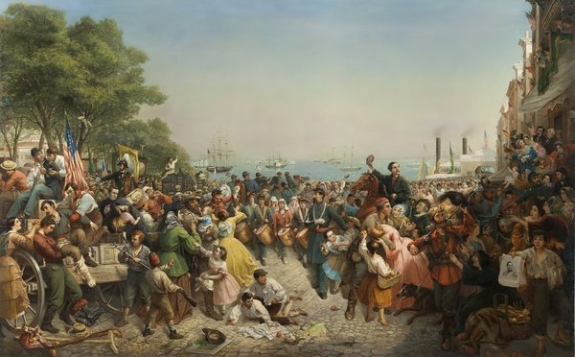Early on the morning of July 27, 1861, the Irish brigade of New York’s 69th Regiment returned From the First Battle of Bull Run, landing by steamboat at what is now Battery Park.
The crowd that massed along the bay to welcome the weary soldiers included all manner of society: flower sellers, fruit vendors, dignitaries, newsboys, grieving widows, well wishers and families of the wounded.
The mood was triumphant — New York’s immigrant boys had returned — but also melancholy; their Civil War battle had ended in defeat. And the artist Louis Lang captured it all on a sprawling canvas in oil paint.
Now “Return of the 69th (Irish) Regiment, N.Y.S.M. From the Seat of War,” restored and reframed, is to become a permanent, prominent fixture in the New-York Historical Society’s renovated building, which reopens, fittingly, on Nov. 11 — Veterans’ Day.
Huge, detailed and colorful, it comes from an era when paintings were expressive and descriptive, tools not only to evoke emotions, but also to do the very real work of simply documenting and recounting history.
“The whole human comedy is played out across the stage of the painting,” said Linda S. Ferber, the society’s vice president and senior art historian. “It’s a combination of the sentimental — of the personal stories — and the collective narrative of this heroic group of men.”
The painting will be the centerpiece of the society’s opening exhibition, “Making American Taste: Narrative Art for a New Democracy,” which looks at taste in art as it was defined from the 1830s to the late 1860s. The society’s other main opening exhibitions include “Freedom Now: Photographs by Platon,” which considers the African-American fight for civil rights through the lens of the British photographer Platon; and ”Revolution! The Atlantic World Reborn,” which relates the American, French and Haitian struggles as a single 18th-century global narrative and features the original Stamp Act document, which is leaving Britain for the first time.
The return of Lang’s panorama, which is about 11 feet wide by 7 feet tall and weighs in at 700 pounds with the frame, required its own renovation. Donated by Lang in 1886, the painting was on display until sometime after World War II, after which the society has difficulty tracking it. Unearthed from storage in 1977, it was in pieces.
So when the society decided to revive the painting in 2006, it meant essentially tackling a jumbo jigsaw puzzle.
“Can we put the painting back together again?” Ms. Ferber said the society asked. “Are the pieces all here?”
The daunting prospect seemed worth the time and $220,000 expense. The painting captures a moment in Civil War history, when the Irish rose to defend the Union and were lauded as heroes. Their joyful homecoming, however, was followed by the 1863 Draft Riots, blamed largely on the Irish.



